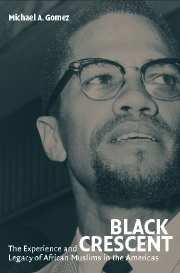Book contents
- Frontmatter
- Contents
- Acknowledgments
- Prologue
- PART ONE
- 1 Ladinos, Gelofes, and Mandingas
- 2 Caribbean Crescent
- 3 Brazilian Sambas
- 4 Muslims in New York
- 5 Founding Mothers and Fathers of a Different Sort: African Muslims in the Early North American South
- Interlude: Into a Glass Darkly – Elisive Communities
- PART TWO
- Epilogue
- Index
Interlude: Into a Glass Darkly – Elisive Communities
Published online by Cambridge University Press: 05 June 2012
- Frontmatter
- Contents
- Acknowledgments
- Prologue
- PART ONE
- 1 Ladinos, Gelofes, and Mandingas
- 2 Caribbean Crescent
- 3 Brazilian Sambas
- 4 Muslims in New York
- 5 Founding Mothers and Fathers of a Different Sort: African Muslims in the Early North American South
- Interlude: Into a Glass Darkly – Elisive Communities
- PART TWO
- Epilogue
- Index
Summary
The preceding chapter has demonstrated a significant Muslim presence in eighteenth- and nineteenth-century North America, a presence with organic, cross-generational extensions into the twentieth century and beyond. It would appear, however, that in addition to an African and African-descended Muslim community in dynamic tension and direct exchange with a larger black population, there may have also been Muslims, both North and West African, who entered the North American mainland in much smaller numbers, intermingling with Native American and European populations at various historical junctures to create transracial, polycultural formations in the hinterlands and in isolation. Given the difficulty of producing definitive statements concerning the historical processes through which such formations passed, it must be stressed here that the present chapter is speculative in the extreme; information on the subject is almost entirely derivative. However, the possibility of a Muslim isolated presence is such that it elevates the discussion to the realm of plausibility and thereby warrants some analysis, with the expectation that further research will render a much less indeterminate approximation.
To begin, there are a number of communities both along the eastern littoral and stretching into the southern and even midwestern interior that have been categorized as ethnically and culturally anomalous, referred to at times as “triracial isolates.”
- Type
- Chapter
- Information
- Black CrescentThe Experience and Legacy of African Muslims in the Americas, pp. 185 - 200Publisher: Cambridge University PressPrint publication year: 2005



